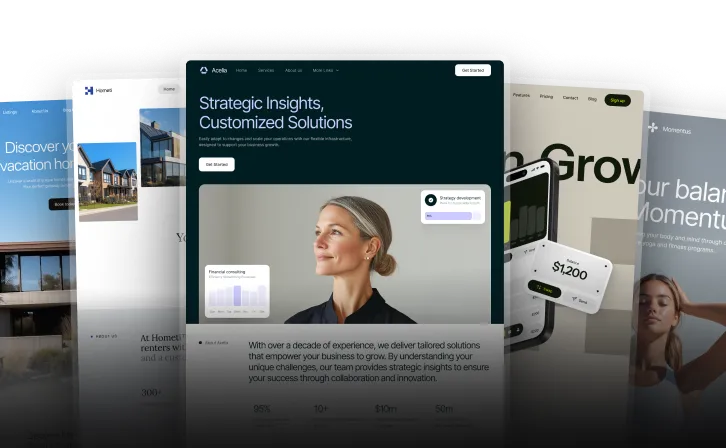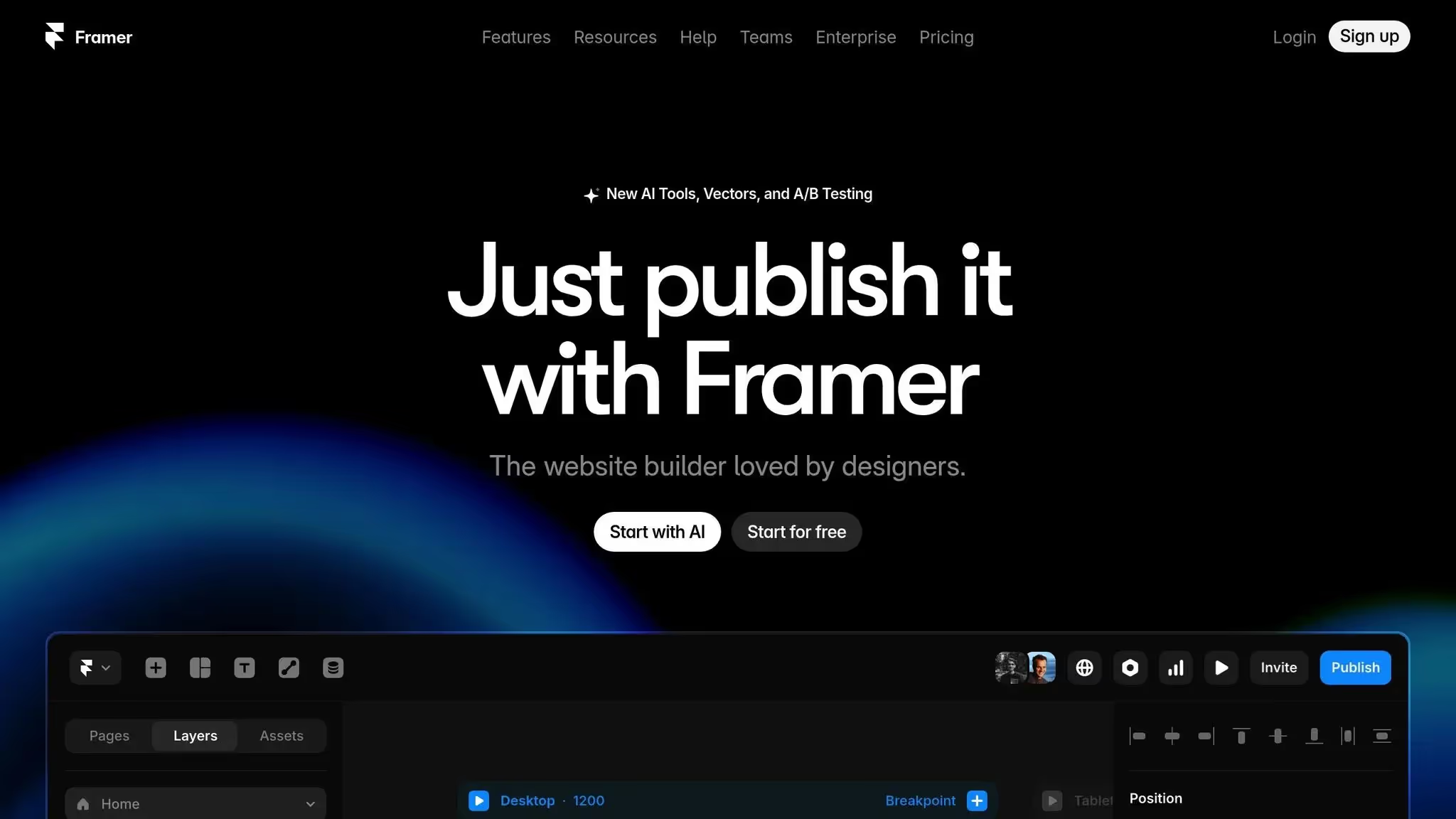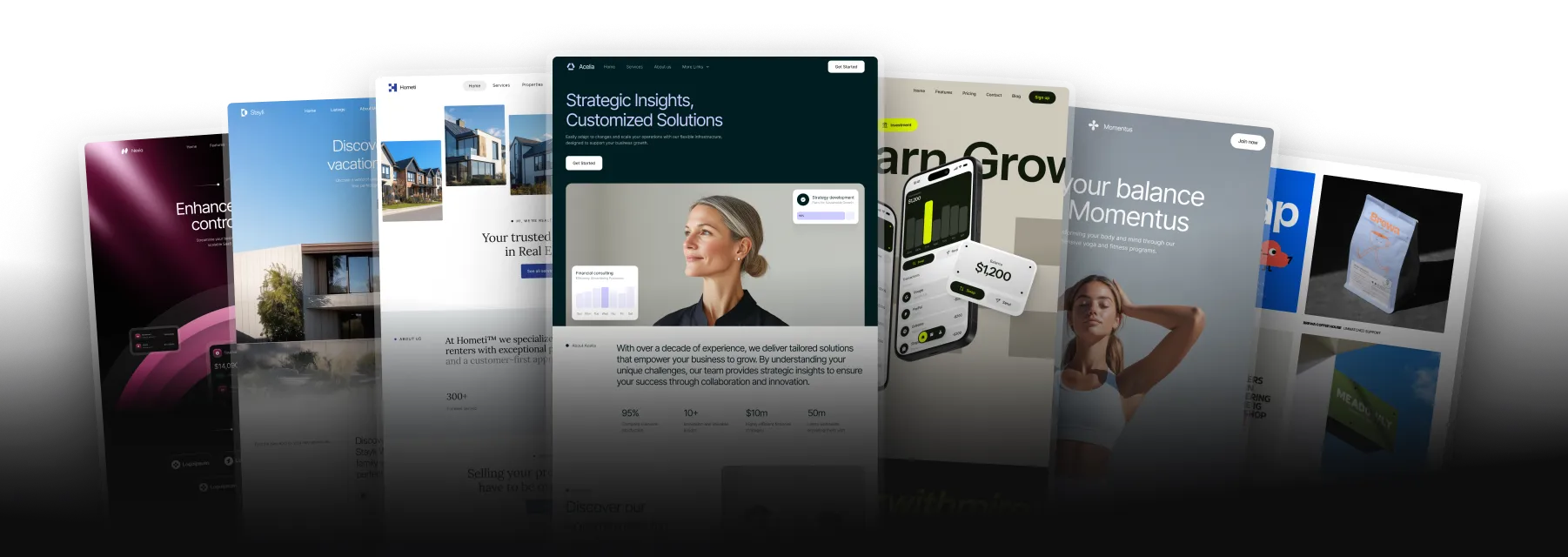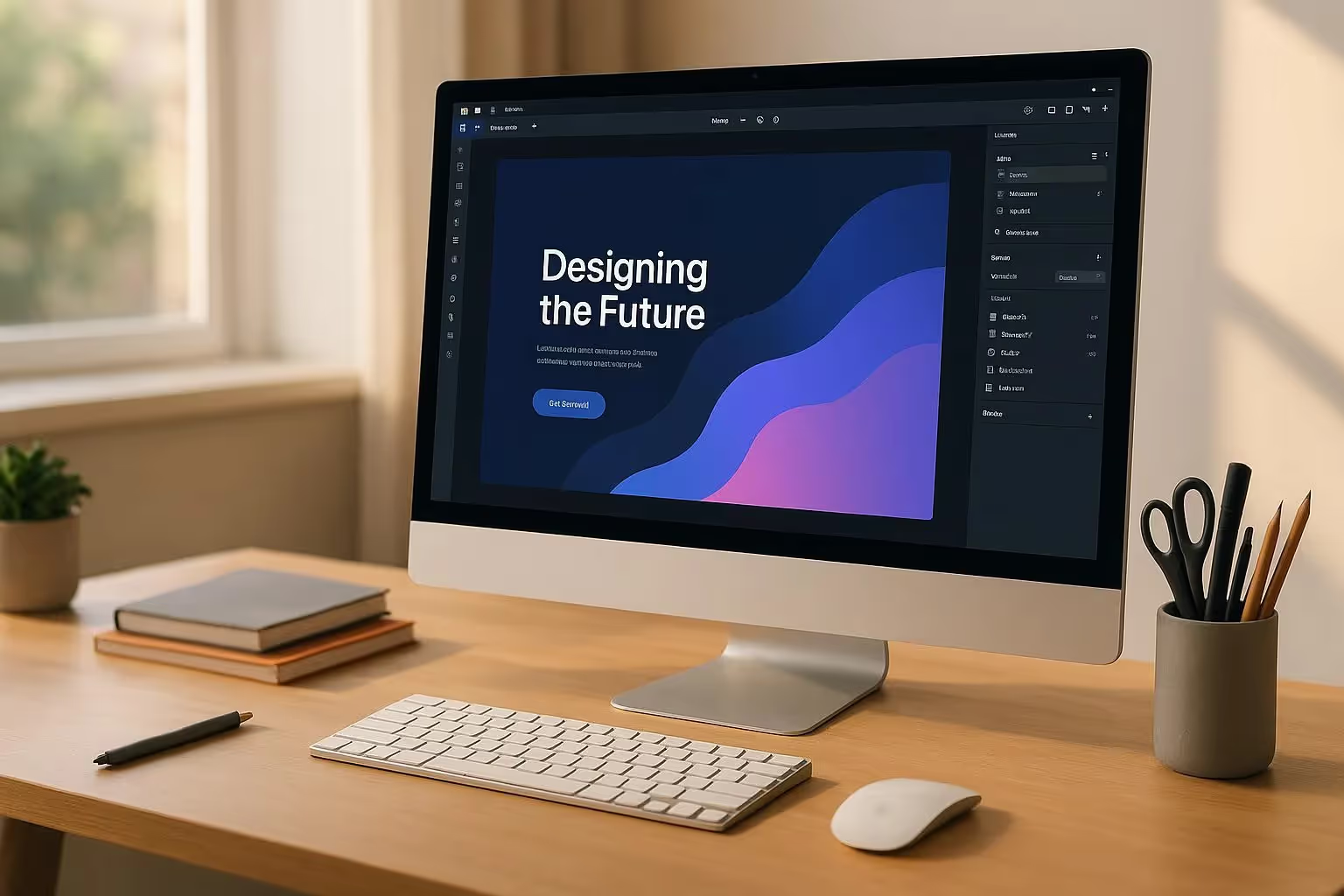5 Gründe, warum Designer sich für Framer statt für Elementor entscheiden
Alle Vorlagen entsperren




Warum wechseln Designer von Elementor zu Einrahmer? Es läuft auf fünf Hauptgründe hinaus: bessere Animationen, fortschrittliches Prototyping, größere Designfreiheit, überlegene Leistung und Unabhängigkeit von herkömmlichen CMS-Plattformen. Hier ist ein kurzer Überblick:
Schneller Vergleich
Merkmal
Framer
Elementor
Fortgeschritten (Frühlingsphysik usw.)
Grundkenntnisse (Fade-Ins, Hover-Status)
Sehr originalgetreu, interaktiv
Grundlegende Live-Vorschauen
Volle Kontrolle, wiederverwendbare Elemente
Eingeschränkt durch Vorlagen
Integrierte Optimierung
Verlässt sich auf Plugins
Eigenständige Plattform
Benötigt WordPress
Framer ermöglicht es Designern, dynamische, leistungsstarke Websites ohne die Einschränkungen herkömmlicher CMS-Plattformen wie WordPress zu erstellen. Sehen Sie sich die Details an, um zu sehen, warum es zur ersten Wahl für modernes Webdesign wird.
Einrahmer Vs Elementor (2025) Hauptunterschiede und welcher ist der richtige für Sie?

1. Bessere Animationen und interaktive Funktionen
Die Animationsengine von Framer zeichnet sich durch hochwertige Animationen aus, die weit über die grundlegenden Einblendungen und Folieneffekte hinausgehen, die üblicherweise in herkömmlichen Seitenerstellern zu finden sind.
Die Animationswerkzeuge von Framer
Framer bietet eine Reihe fortschrittlicher Animationstools, darunter Spring Physics, zeitleistenbasierte Bewegungsbearbeitung und Optimierung mit 60 Bildern pro Sekunde, die alle darauf ausgelegt sind, reibungslose, professionelle Animationen zu erstellen — ohne eine einzige Codezeile schreiben zu müssen.
Mit Keyframe-Animationen können Designer alles von subtilen Mikrointeraktionen bis hin zu komplizierten, mehrstufigen Sequenzen über eine einfache visuelle Oberfläche erstellen.
„Framer bietet eine leistungsstarke, visuelle Plattform für die Gestaltung und Prototypenerstellung interaktiver Benutzererlebnisse — ohne Code... Erwecken Sie Designs mit flüssigen Animationen und realitätsnahen Verhaltensweisen zum Leben, und das alles ohne Code.“
Framer bietet auch kreative Effekte wie Hover-, Drag-, Loop- und Press-Animationen, sodass Designer die Flexibilität haben, ansprechende und ansprechende Benutzerinteraktionen zu erstellen. Das Spring Physic-System sorgt dafür, dass sich Animationen natürlich anfühlen und realistisch auf Benutzereingaben reagieren.
Für Entwickler, die mit arbeiten Reagieren, Framer Motion, die integrierte Animationsbibliothek, bietet ein robustes Toolkit für die Erstellung dynamischer Animationen. Diese Integration gewährleistet eine reibungslose, konsistente Leistung aller Browser und Geräte, sodass keine zusätzlichen Optimierungsarbeiten erforderlich sind.
Diese Tools bieten nicht nur zusätzliche technische Funktionen, sie verändern auch die Art und Weise, wie Benutzer Portfolio- und Produktseiten erleben, und machen sie interaktiver und visuell ansprechender.
Vorteile für Portfolio- und Produktseiten
Die Animationsfunktionen von Framer eignen sich besonders für die Erstellung interaktiver Portfolios und Produktpräsentationen, insbesondere für SaaS- und Technologieunternehmen. Mithilfe von Tools wie Mikrointeraktionen können Designer Schaltflächen erstellen, die beim Schweben mit der Maus pulsieren, oder Fortschrittsbalken, die nahtlos animiert werden. Diese kleinen, aber wirkungsvollen Details können zu unvergesslichen Benutzererlebnissen führen und Marken helfen, sich auf überfüllten Märkten abzuheben. Darüber hinaus bieten animierte Benutzeroberflächenelemente ein klares visuelles Feedback, das Benutzer durch Interaktionen führt oder sie auf Fehler aufmerksam macht.
Für Portfolio-Websites ermöglicht Framer Kreativen, ihre Arbeiten auf einzigartige Weise zu präsentieren, z. B. in interaktiven Galerien, animierten Fallstudien und dynamischen Navigationssystemen. Auf Produktseiten verbessern Animationen die Vorführung von Funktionen, machen Preistabellen ansprechender und sorgen für reibungslose Übergänge bei den Call-to-Action-Elementen, wodurch die Nutzer effektiv durch den Konversionstrichter geführt werden.
Vergleich der Animationsfunktionen
Die Animationsfunktionen von Framer stehen in krassem Gegensatz zu denen herkömmlicher Seitenersteller wie Elementor. So vergleichen sie sich:
Merkmal
Framer
Elementor
Spring Physics, Keyframes, benutzerdefiniertes Easing, gestenbasierte Interaktionen
Grundlegende Eingangsanimationen, Scroll-Effekte, einfache Hover-Zustände
60-fps-Optimierung, integrierte Leistungsüberwachung
Erfordert zusätzliche Plugins zur Optimierung
Volle Kontrolle über Timing, Lockerung und komplexe Abläufe
Beschränkt auf voreingestellte Animationsoptionen
Drag-Interaktionen, Multitouch-Gesten, zustandsbasierte Animationen
Grundlegende Interaktionen beim Klicken und Schweben
Visueller Timeline-Editor mit Keyframe-Steuerung
Keine zeitleistenbasierte Animationsbearbeitung
Die Animationsengine von Framer ermöglicht ausgeklügelte Interaktionen, die in Elementor nur schwer oder sogar unmöglich zu erreichen wären, ohne auf mehrere Plugins angewiesen zu sein. Elementor bietet zwar grundlegende Funktionen wie Scrolleffekte und Eingangsanimationen, aber es fehlt ihm an der Komplexität und Präzision, die Framer bietet.
Wenn man bedenkt, dass fast die Hälfte der Nutzer eine Seite verlässt, wenn das Laden länger als drei Sekunden dauert, ist die integrierte Leistungsoptimierung von Framer ein großer Vorteil. Sein moderner Ansatz für responsives Design, bei dem der Schwerpunkt auf den Core Web Vitals und der Leistung liegt, gewährleistet ein nahtloses Nutzererlebnis. Dieser Fokus auf Geschwindigkeit und Fluidität ist entscheidend, da Designer bestrebt sind, zunehmend interaktive und ansprechende digitale Erlebnisse zu bieten.
2. Integriertes Prototyping und Teamzusammenarbeit
Framer erfindet die Art und Weise, wie Designteams zusammenarbeiten, neu, indem es fortschrittliche Prototyping-Tools mit Teamwork-Funktionen in Echtzeit kombiniert. Dieser All-in-One-Ansatz ersetzt die Notwendigkeit, mit mehreren Tools zu jonglieren, und macht ihn zu einem Wendepunkt für verteilte Teams und Agenturen.
Schnelles Prototyping in Framer
Framer bringt das Prototyping auf die nächste Stufe und bietet viel mehr als einfache Mockups. Mit originalgetreue interaktive Prototypen, Designer können dynamische, ansprechende Designs erstellen. Dank KI-gestützter Tools können ganze Websites aus einfachen Texteingaben generiert werden, was sowohl Zeit als auch Ressourcen spart.
Framer unterstützt ausgeklügelte Interaktionen wie staatliche Verwaltung, mit dem Konstrukteure Komponenten mit mehreren interaktiven Zuständen erstellen können, was die Reaktionsfähigkeit verbessert. Es beinhaltet auch Gestensteuerung — wie Wischen, Ziehen und Scrollen — damit erhalten Web-Prototypen app-ähnliche Funktionen. Hinzufügen Hardwarebeschleunigung fügen Sie den Mix hinzu, und Sie erhalten reibungslose Übergänge und hohe Bildraten auf allen Geräten.
Für diejenigen ohne Programmierkenntnisse bietet Framer's No-Code-Funktionen machen es einfach, animierte Prototypen zu bauen. Entwickler hingegen können sauberen, produktionsreifen Code exportieren, was den Übergang vom Design zur Entwicklung vereinfacht.
Aber Framer hört nicht beim Prototyping auf — es zeichnet sich auch dadurch aus, dass es Teams zusammenbringt.
Tools für die Teamzusammenarbeit
Die Kollaborationsfunktionen von Framer wurden entwickelt, um die Produktivität zu steigern und die Arbeitsabläufe für Agenturen zu optimieren. Teams können gleichzeitig an demselben Projekt arbeiten, wobei Änderungen und Aktualisierungen in Echtzeit sichtbar sind.
„Große Dinge passieren zusammen. Arbeiten Sie live auf einer Leinwand zusammen.“ - Framer
Diese Live-Zusammenarbeit bedeutet, dass Designer, Entwickler und Stakeholder Projekte problemlos gemeinsam bearbeiten, überprüfen und verfeinern können. Das Ergebnis? Schnellere Entscheidungsfindung und weniger Engpässe.
Framer beinhaltet auch design asset management tools, allowing agencies to store and organize all their assets in one centralized location. It seamlessly integrates with tools like Sketch, Figma, and Adobe XD, ensuring compatibility with existing workflows. For client collaboration, Framer shines by enabling clients to interact directly with prototypes, offering a hands-on experience instead of relying on static images or lengthy explanations.
Prototyping and Collaboration Comparison
When comparing Framer to Elementor, their differences in prototyping and collaboration capabilities become clear:
Feature
Framer
Elementor
High-fidelity interactive prototypes with AI tools
Basic live previews with limited interactivity
Multiple users can edit simultaneously with live updates
Limited to WordPress user roles and permissions
Interactive prototypes clients can explore firsthand
Static previews requiring external feedback tools
Centralized storage for design assets
Uses WordPress media library
Connects with Sketch, Figma, Adobe XD
Focused on WordPress integrations
Clean, production-ready code
WordPress-specific output needing extra optimization
Framer stands out with its high-fidelity prototypes and smooth handoff to developers, features Elementor lacks. While Elementor provides live previews within WordPress, it doesn’t offer the advanced prototyping tools needed for complex projects.
For distributed teams, Framer’s real-time collaboration tools are among the best in the industry, enabling seamless teamwork regardless of location. Agencies looking to streamline their design and prototyping workflows will find Framer’s integrated platform a powerful solution to boost team efficiency and impress clients.
3. More Design Freedom and Customization
Framer doesn’t just stop at delivering smooth animations and quick prototyping - it also offers unparalleled freedom when it comes to design and customization. Unlike template-based builders that box you into predefined layouts, Framer’s code-powered visual editor combines the flexibility of coding with the ease of visual design. This means you can create custom layouts and reusable components tailored to your needs. Whether you’re building from scratch or refining existing elements, Framer puts you in complete control.
Code-Based Design in Framer
Framer takes a step beyond the limitations of traditional page builders. It provides a genuine design canvas - not just a visual HTML editor. With Framer, you can design custom layouts and reusable components like headers, footers, and navigation menus, ensuring consistency across all your projects.
"Framer provides a fully flexible visual canvas, allowing designers to create without constraints. Unlike rigid template-based builders, Framer gives complete creative control over layout, typography, and interactions." – Framer
While Framer does have a steeper learning curve compared to basic drag-and-drop tools, the trade-off is worth it. Creative professionals gain complete control over both the functionality and appearance of their sites - without needing to dive deeply into coding.
Industry-Specific Design Solutions
Framer’s flexibility becomes even more apparent when designing for specific industries. Whether it’s SaaS, real estate, or wellness, Framer adapts seamlessly to deliver tailored solutions. For instance, in 2022, Acapela transitioned its website from Webflow to Framer, speeding up page deployment times. Similarly, LottieFiles embraced Framer, allowing their design team to make updates independently of developers.
Framer also excels with responsive design, offering advanced effects like appear effects, text animations, parallax scrolling, and looping animations. These features make it easier to craft modern, interactive websites that engage users. For those with unique industry needs, Framer’s specialized templates can jumpstart the design process, saving time while maintaining precision.
Temlis Premium Framer Templates

For businesses in the United States, Temlis provides premium Framer templates tailored to key industries. These templates cover sectors like finance and SaaS (e.g., Advisora and Miros at $129 each), real estate (Elevates at $79), wellness and fitness (Calmy and Harmoni at $79 each), and professional services (Legally at $79). Each template is fully customizable, allowing you to align the design with your brand.
What sets these templates apart is their flexibility. Framer makes it easy to adjust colors, fonts, and images to match your branding. You can even go further by reworking layouts, adding custom interactions, or building entirely new sections - all without running into technical limitations.
Customization Aspect
Framer
Elementor
Complete pixel-perfect freedom
Limited to pre-built sections
Design and reuse custom elements
Relies on existing widgets
Tools for any industry requirement
WordPress-focused with plugins
Seamless combination of code and design
Requires plugins for advanced features
Extensive customization options
Modifications within WordPress limits
While template-based builders like Elementor can simplify initial development, they often restrict deeper customization. Framer, on the other hand, operates independently of CMS limitations, offering the flexibility needed to create truly unique, brand-specific designs.
sbb-itb-fdf3c56
4. Better Performance and Mobile Design
In today’s mobile-first world, website performance is non-negotiable. Framer stands out by offering exceptional performance optimization and responsive design tools without the need for extra plugins - something often required by WordPress-based platforms. This streamlined approach results in faster load times, higher search rankings, and seamless experiences across devices. Let’s break down how Framer's performance and mobile-first design make it a standout choice.
Performance Optimization with Framer
Framer is built with Google's Core Web Vitals in mind. Unlike platforms that depend on numerous plugins (which can bog down a site), Framer's architecture ensures consistently fast loading speeds. Features like server-side rendering, lazy loading, and automatic image optimization are baked in, working together to deliver 90+ Lighthouse scores right out of the box - no plugins required.
To put this into perspective, Elementor achieves a website speed optimization score of 6.7/10, while Framer scores 7.4/10. This gap widens when you consider that Elementor often depends on caching plugins, CDN setups, and code minification tools to achieve similar results. Framer, on the other hand, handles these optimizations automatically, saving time and reducing complexity.
Built-In Mobile-First Design
Framer takes a modern approach to responsive design. Its tools automatically adjust layouts for different screen sizes, eliminating the need for manual tweaks. Designers can even make edits directly from a mobile browser - though this feature may be less practical for intricate adjustments.
This mobile-first philosophy extends to performance metrics as well. While WordPress sites built with Elementor often struggle with mobile Lighthouse scores between 20–40, Framer sites consistently deliver stronger mobile performance. This difference highlights Framer's ability to provide a smoother and faster experience for mobile users.
Performance and Mobile Design Comparison
Performance Aspect
Framer
Elementor
Built-in optimization
Requires additional plugins
90+ without plugins
Typically 20–40 on mobile
7.4/10 rating
6.7/10 rating
Direct edits via mobile browser
Responsive preview mode
Server-side rendering, lazy loading, auto image optimization
Relies on caching plugins, CDN, and code minification
Maintains speed as the site grows
Slows down with multiple plugins
Why Framer Stands Out
More companies are moving away from WordPress and Elementor due to concerns about performance and scalability. Framer's built-in optimizations and simplified architecture are particularly appealing for U.S.-based designers working with clients who value fast load times and excellent mobile performance. By eliminating the need for multiple optimization plugins, Framer not only simplifies the process but also ensures consistently high performance across devices. This makes it a go-to platform for modern web design that prioritizes both speed and usability.
5. No CMS Dependencies
Framer stands out with its ability to function independently from traditional CMS systems, offering a streamlined approach to web management. Unlike platforms like Elementor, which rely heavily on WordPress - and all the hosting, plugins, security updates, and maintenance that come with it - Framer operates as a self-contained platform, eliminating these extra layers of complexity.
Framer as an All-in-One Solution
With Framer, you don’t need to juggle separate hosting services, plugins, or CMS updates. Everything is built into the platform, making site management simpler and more efficient. Framer provides integrated hosting optimized for performance, automatic maintenance, and built-in security measures - all in one package.
Framer’s built-in CMS is directly tied to its design canvas, allowing teams to manage content at scale without ever leaving the platform. It also offers comprehensive SEO tools such as schema markup, sitemaps, redirects, and semantic tags. On top of that, Framer supports translation, image swapping, and localized design tweaks, all powered by its integrated AI. This cohesive setup ensures smooth scaling and hassle-free updates.
Effortless Scaling and Updates
Framer is built to handle growth effortlessly, making it a great fit for businesses with expanding content or evolving design needs. Unlike WordPress, which can slow down as plugins and content pile up, Framer maintains its performance consistency regardless of scale.
Cost-wise, Framer offers significant savings. Basic plans start at just $5/month, compared to the $1,500–$3,000/month often spent on WordPress maintenance. This difference stems from Framer’s hands-off approach - there’s no need for constant updates or plugin management, which are unavoidable with WordPress.
Here’s a real-world example: In March 2025, a Michigan pet store switched to Framer and saw a 40% boost in website traffic and a 30% increase in sales. Framer also comes with automatic SSL certificates and built-in security features, addressing vulnerabilities that plague about 70% of WordPress sites due to outdated components. Plus, with global CDN integration and image optimization, Framer ensures fast load times and consistently high Lighthouse scores above 90.
Why U.S. Designers Benefit
For designers and businesses in the U.S., Framer’s independence from traditional CMS systems offers several advantages. Its no-maintenance design reduces the need for dedicated tech staff, which is especially beneficial for smaller agencies and freelancers. By combining design, prototyping, and development into one platform, Framer minimizes technical challenges and allows designers to focus on their creative work instead of troubleshooting.
The platform’s all-inclusive features and automation also lead to lower overall costs, making it an appealing choice for budget-conscious businesses. It’s particularly well-suited for those who value strong visual design, have limited technical resources, need to roll out marketing campaigns quickly, or want to cut development expenses.
CMS Dependency Aspect
Framer
Elementor + WordPress
Standalone platform
Plugin requiring WordPress
$5–$200/month
$1,500–$3,000/month
None required
Constant oversight needed
Built-in protection
70% of sites vulnerable
Minimal
Dedicated tech support
Integrated hosting
Separate hosting required
None
Multiple plugins required
Framer’s departure from traditional CMS dependencies marks a new era in web design, empowering designers to achieve more with fewer obstacles and reduced overhead.
Conclusion: Why Framer Stands Out
Framer addresses the demands of modern web design with a blend of sleek animations and a hassle-free approach to content management.
Its animations, prototyping tools, and code-powered design features give creators the tools they need to craft unique and engaging layouts with ease. On top of that, Framer's technical capabilities ensure a smooth experience for designers and users alike.
With built-in performance enhancements and a structure that doesn't rely on a traditional CMS, Framer eliminates the need for extra plugins or constant adjustments. This not only boosts SEO but also enhances the overall user experience.
Adding to these advantages, Temlis premium Framer templates provide an excellent starting point for creating designs tailored to specific industries. Whether it’s the Vetic template for veterinary services or the Advisora template for finance, these templates help designers achieve professional, customizable results without wasting time.
FAQs
How does Framer's animation engine improve user experience compared to traditional web design tools?
Framer's animation engine, driven by Framer Motion, turns static designs into lively, interactive experiences. With tools for smooth transitions, responsive gestures, and detailed animations, it empowers designers to craft websites that feel more dynamic and engaging.
These animations do more than just look good - they help direct user attention and offer instant feedback, making interactions feel seamless and intuitive. By weaving movement and storytelling into the user experience, Framer keeps visitors engaged longer and elevates their overall satisfaction.
How do Framer's prototyping and collaboration tools benefit design teams?
Framer's tools for prototyping and collaboration bring some solid benefits to design teams. With real-time collaboration, team members can work on the same project at the same time, making feedback smoother and revisions quicker. Plus, the ability to build interactive prototypes lets designers explore realistic user interactions early on, helping create designs that truly focus on user needs.
What sets Framer apart is how it combines design and prototyping in one platform, bridging the gap between designers and developers. Its version control system ensures changes are easy to track, keeping the entire team on the same page. And thanks to its intuitive interface, teams can channel their energy into creativity and deliver results more efficiently, without getting stuck on technical challenges.
How does Framer's independence from a CMS benefit web designers and businesses?
Framer stands out by operating independently of a CMS, offering unmatched design flexibility. This setup gives web designers the freedom to craft custom solutions without being tied down by the constraints of a traditional CMS structure. The result? Designs that are tailored to the project, featuring advanced animations and seamless prototypes.
For businesses, this translates to quicker project completion and the agility to respond to shifting needs. Designers retain full creative control, ensuring the final product meets client expectations perfectly. On top of that, Framer's user-friendly tools and streamlined collaboration features make teamwork smoother, helping teams deliver polished, high-quality results with ease.
Related posts
- Webflow vs Framer: Choosing the Right Platform in 2025
- Wordpress Alternative for 2025
- Framer vs WordPress: Which Website Builder is Right for You
- Framer vs Elementor: Which Website Builder is Right for You
{"@context":"https://schema.org","@type":"FAQPage","mainEntity":[{"@type":"Question","name":"How does Framer's animation engine improve user experience compared to traditional web design tools?","acceptedAnswer":{"@type":"Answer","text":"<p>Framer's animation engine, driven by <strong>Framer Motion</strong>, turns static designs into lively, interactive experiences. With tools for smooth transitions, responsive gestures, and detailed animations, it empowers designers to craft websites that feel more dynamic and engaging.</p> <p>These animations do more than just look good - they help direct user attention and offer instant feedback, making interactions feel seamless and intuitive. By weaving movement and storytelling into the user experience, Framer keeps visitors engaged longer and elevates their overall satisfaction.</p>"}},{"@type":"Question","name":"How do Framer's prototyping and collaboration tools benefit design teams?","acceptedAnswer":{"@type":"Answer","text":"<p>Framer's tools for prototyping and collaboration bring some solid benefits to design teams. With <strong>real-time collaboration</strong>, team members can work on the same project at the same time, making feedback smoother and revisions quicker. Plus, the ability to build <strong>interactive prototypes</strong> lets designers explore realistic user interactions early on, helping create designs that truly focus on user needs.</p> <p>What sets Framer apart is how it combines design and prototyping in one platform, bridging the gap between designers and developers. Its <strong>version control</strong> system ensures changes are easy to track, keeping the entire team on the same page. And thanks to its intuitive interface, teams can channel their energy into creativity and deliver results more efficiently, without getting stuck on technical challenges.</p>"}},{"@type":"Question","name":"How does Framer's independence from a CMS benefit web designers and businesses?","acceptedAnswer":{"@type":"Answer","text":"<p>Framer stands out by operating independently of a CMS, offering <strong>unmatched design flexibility</strong>. This setup gives web designers the freedom to craft custom solutions without being tied down by the constraints of a traditional CMS structure. The result? Designs that are tailored to the project, featuring advanced animations and seamless prototypes.</p> <p>For businesses, this translates to quicker project completion and the agility to respond to shifting needs. Designers retain full creative control, ensuring the final product meets client expectations perfectly. On top of that, Framer's user-friendly tools and streamlined collaboration features make teamwork smoother, helping teams deliver polished, high-quality results with ease.</p>"}}]}
Recommended posts
Alle Vorlagen entsperren







